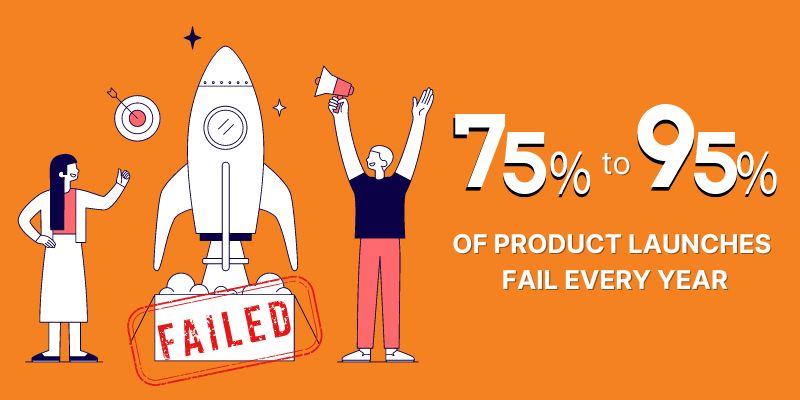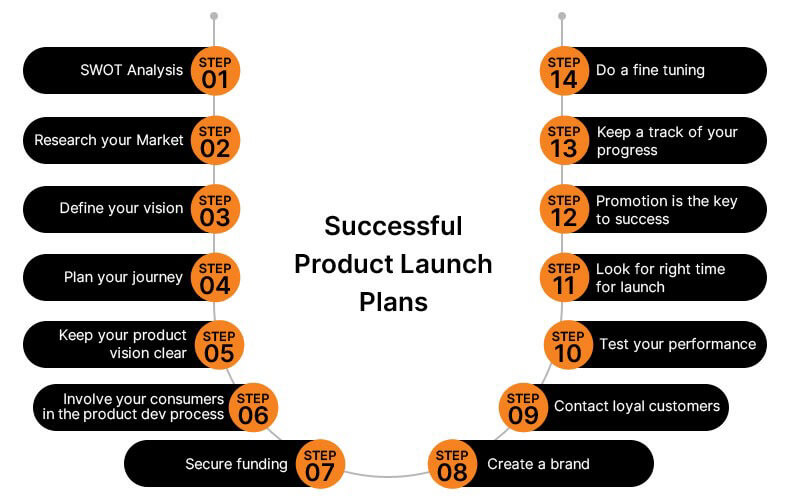Quick Summary: Ninety-five percent of the newly launched products fail. Here’s your bible to help you launch a successful product. Your product’s future may depend on this. Take it!
As the saying goes, “the sky’s the limit.” If you are a product owner with a great idea & a marketable product, you might think, what could go wrong now?
But according to Harvard Business School, more than 30,000 products are launched each year, and almost 95 percent fail.
The numbers are enormous, aren’t they?
Not only this, even Professor Inez Blackburn, University of Toronto, states that the failure rate of new grocery store products is around 70 to 80 percent.
Why are the products failing so miserably? And as a fact, from Coca-Cola to Colgate, even the big sharks aren’t immune to this failure. So, we can easily interpret that plenty of good products fail too! There can be several reasons for the same- Insufficient funding, poor promotion & lack of market knowledge are a few of them.
We understand product launches are complex, but by hiring dedicated team, you can stand out in the market. But till then, we can help you learn from past mistakes and help you understand the process in a more straightforward form;
Product Launch Mistakes: Real-life Use-cases

Use-case 1: How the company’s stagnant growth affected the Mosquito Magnet
The Lesson: Always have the plan to scale when your product performs well in the market.
In 2000, American Biophysics launched a product-Mosquito Magnet, which used carbon dioxide to attract mosquitos into traps.
The product launch time was perfect, as after the West Nile virus, mosquitoes were viewed as deadly disease carriers.
As the product gained popularity, the company decided to expand from Rhode Island to China, from low-volume production to mass production. As the company expanded the product reach, the quality dropped, leading to a loss in the consumer market.
Despite having once generated $70 million in revenue annually, American Biophysics was sold to Woodstream for just $6 million.
The product is paying well to Woodstream today but generated a loss for the original shareholders.
Use-case 2: Microsoft Windows Vista: Product fails to live up to claims and is panned
The Lesson: Launch the product only when it is ready for the market.
While launching Microsoft Windows Vista, the marketing done by the company raised expectations of the media and the consumer market.
The organization, which allocated $500 million for the marketing, predicted that at least 50% of the users would run the premium edition within two years.
But as the software launched, several compatibility and performance issues made even the loyal customers turn around. As a result, Vista flopped.
Flaw 3: How not researching the market well backfired for Coca-Cola
The Lesson: Make sure the product is different enough to sway customers to buy it.
Coca-Cola had always ruled its niche market, and after some time, the brand wanted to expand.
Identifying the new market- 20 to 40-year men who liked the idea of low carb coke, Coke C2 was introduced in 2004 with a $50 million advertising campaign.
However, the product was unsuccessful due to insufficient benefits delivered by C2. An inadequate marketing budget also played a major role in its failure.
This low-carb drink was a short-lived trend. The target audience needed more time to prepare a low-carb drink with a sour taste.
Now, the question arises, why weren’t these issues identified earlier before the launch?
This was due to partial or utterly wrong market research. Learning from its mistake, Coca-Cola launched Coke Zero a year later, a no-cal drink with full flavor, which is performing well in the market today.
Hence, it all comes down to proper market research, making the product market ready, and a few more details to make your product successful.
[Also Read: Mistakes you must avoid when planning your product roadmap]
Here are a few steps that can help you plan a successful product launch;
How to Plan a Successful Product Launch?

Product launches require a lot of research and planning. This 14 point list would help you achieve the same:
Step 1: SWOT Analysis
Do a SWOT analysis of the product. Identify your strengths & weaknesses. Do market research for your competitors.
How is your competition doing? Where are they lacking? How can you improve your product?
Create a SWOT chart and mention your strengths, weaknesses, opportunities, and threats.
Step 2: Research your Market
Ensure that you are doing extensive market research. What is the audience looking for?
Go for interviews, surveys, and goal-oriented analytical research.
Step 3: Define your Vision
How would your audience do the same if you cannot define your product?
Define the purpose of your product, and make sure your entire organization understands the same.
Step 4: Plan your Journey
Plan your product launch journey. Make sure it is attainable, and break it down into simpler goals.
A well-planned journey can ensure that a whirlwind doesn’t turn into a disruptive tornado.
Step 5: Keep your Product Vision Clear
In the middle of all the product launch chaos, it is simple to lose sight of your vision.
Invest in project management software that would keep track of all the essential operations.
Step 6: Involve your Consumers in the Product Dev Process
Create a Minimum Viable Product that would help you test the market, and gather the early feedback you require.
[Also Read: Unleashing the Power of Minimum Viable Product (MVP) for a Business]
Step 7: Secure Funding
Funding is necessary to ensure that your product reaches the market. Secure your funding, and keep your investors in a loop.
According to Forbes, 99.95 percent of start-ups will not get venture capital funding.
Step 8: Create a Brand
Invest in your product, and create a unique brand to help you scale better. A brand sticks with the customers, and you need that.
Step 9: Get in Touch with your Loyal Customer
Research who your key audience is, and stay in touch with them. They are your advocates and would tell you how your product is doing.
Step 10: Test your Performance & Usability
Gather your team of designers, copywriters, and DevOps and ensure that everything runs smoothly.
According to Localytics, 21% of users give up on the app just after a single usage.
Step 11: Look for a Suitable Time for the Launch
Figure out the right time for your product launch. Don’t select a random date, do well-defined research for the same.
Step 12: Promotion is the Key to Success
Make noise, and make sure that world hears it! There are several ways to promote- press releases, videos, digital advertisements, or bloggers, to name a few.
Please make the most of them and let the world know of your product.
Step 13: Keep Track of your Progress
Measure the results and compare them to your project goals, vision, and projections. Consider making a second SWOT chart to assess your progress.
Step 14: Do a Fine-tuning
Once the final iteration of the product hits the market, you should listen to your consumers to continuously evolve and improve.
Final Thoughts
Proper planning is essential for guaranteeing the success of your product launch.
Investing in appropriate product development company will assist you in planning launch dates, allocating resources, and keeping all of your schedules in sync and on track.
It will enable your staff (and investors) to collaborate in real-time from anywhere via the cloud. The more organized you are in the new launch, the better.
Looking for a reliable team to help you develop and market your product?
Contact Us Now
Summary
Kickstart Your Project With Us!
Popular Posts
CONTACT US
Let's Build Your Agile Team.
Experience Netsmartz for 40 hours - No Cost, No Obligation.
Connect With Us Today!
Please fill out the form or send us an email to







